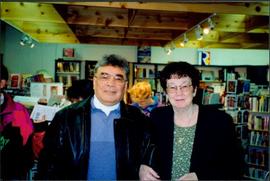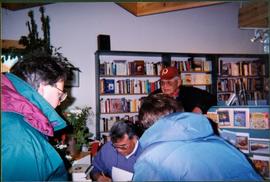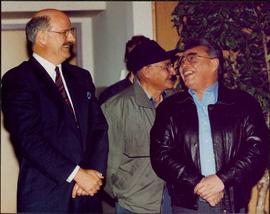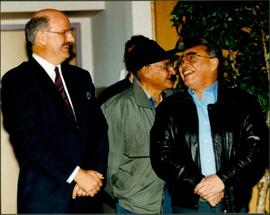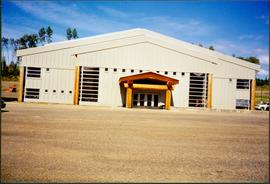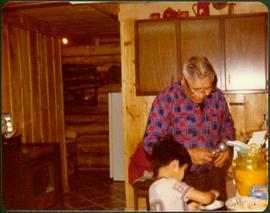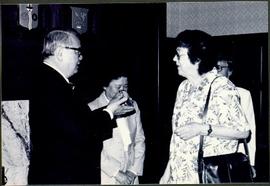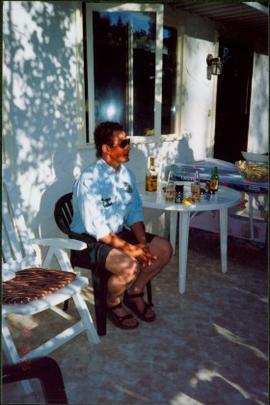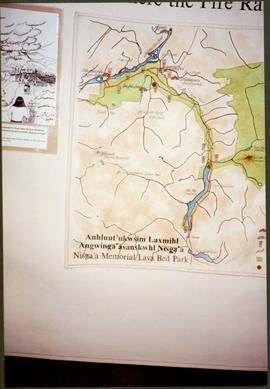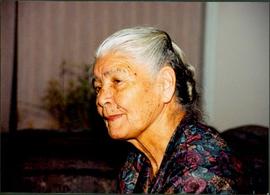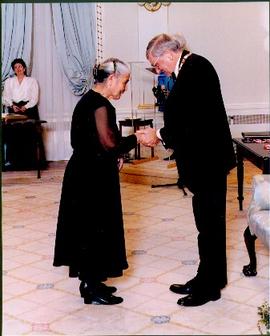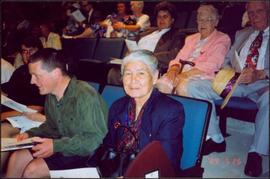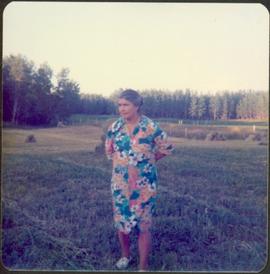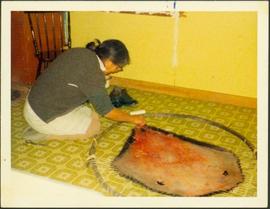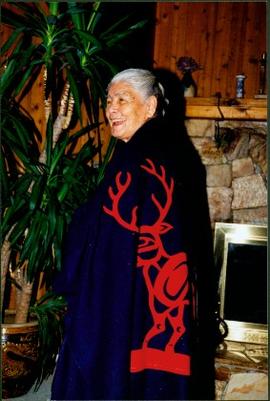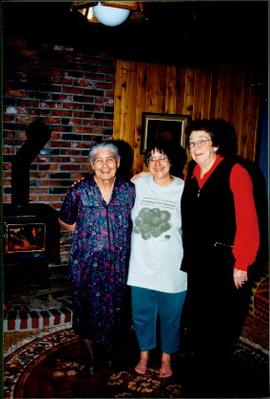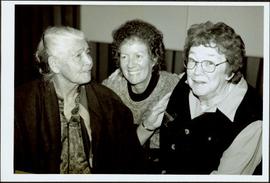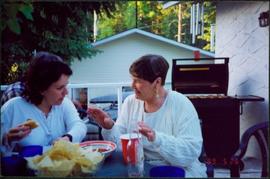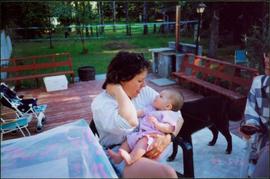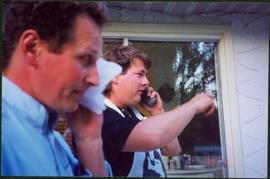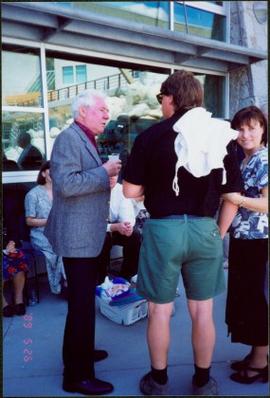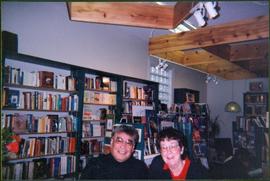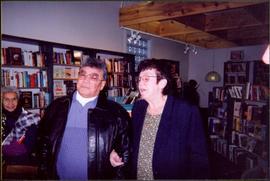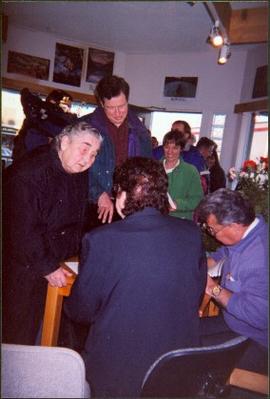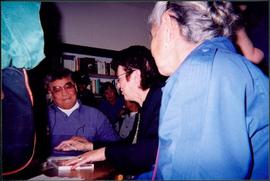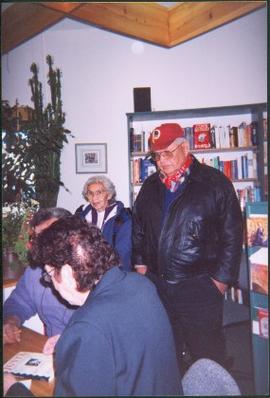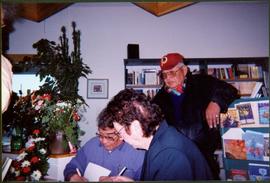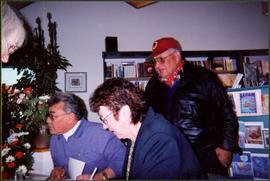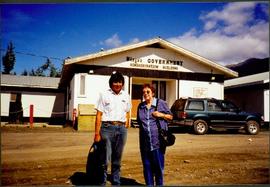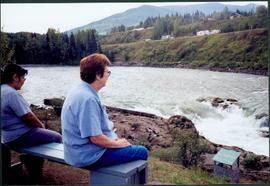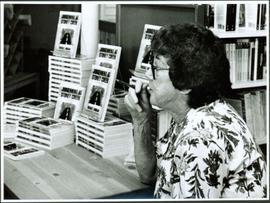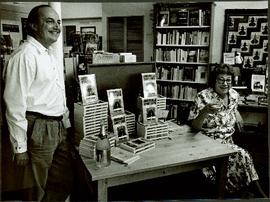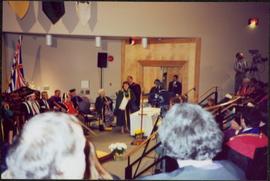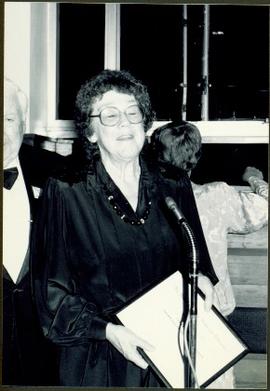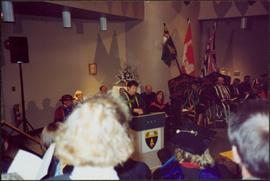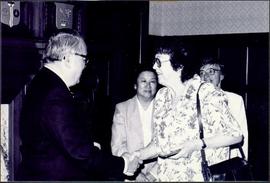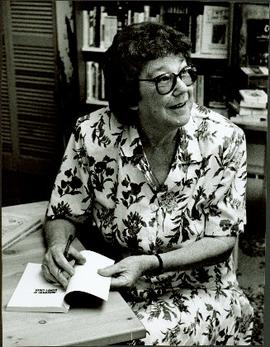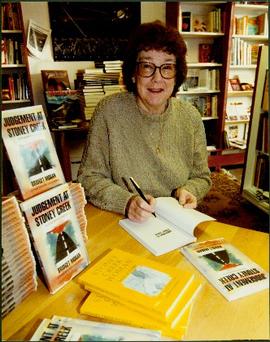Justa Monk and Bridget Moran stand in foreground. Unidentified individuals can be seen in bookstore in background. Bridget Moran published a book in 1994 entitled 'Justa: A First Nations Leader, Dakelhne Butsowhudilhzulh'un'.
Item is a recorded audio interview with Justa Monk.
Audiocassette Summary
SIDE 1
00:04 Moran asks Justa when and where he was born. In Fort St. James, Nov. 20, 1942 in his father’s home. Moran asks about Justa’s mother’s family and her relationship to Eddie John. His mother had a big family, 2-3 sisters, and quite a few brothers. She was from Portage and his dad was from Babine Lake. Both ended up in Tachie after meeting in Fort St. James and marrying in 1924. Their marriage was arranged: a long time ago that is how marriages were made. His parents were born in 1900 and married in 1924. His mother was married before and had one child but this first husband died. The child’s last name was Maurice. After getting married, his parents moved to Portage to work on his father’s farm acreage outside the reserve. When Justa went to Lejac in ’54, he was accused of being non-status by Dept. of Indian Affairs and tried to kick him and his brother out of Lejac because this farm was off reserve. In 1954 the Monks moved back to Tachie after all his older brothers and sisters got married in Tachie.
4:35 His parents lived away from Tachie for about 30 years. They moved back to Tachie after working in Fort St. James, Douglas Lodge and Nakalak Lodge on Stewart Lake. Bridget wondered who owned the lodge back then? Justa says it was owned by Harry McConnachie. Justa’s father worked at this lodge as a guide.
5:03 Justa was the baby of a family of 11. Justa was born in 1942, when his mother was 42. His mother was born Feb. 18, 1900, his Dad May 15, 1900: so they were both about same age. They were married 67 years. His Mom died March 17, 1992. She was still sewing slippers at age 92. Bridget Moran talks about taping Granny Seymour as part of her social work when she was 111-112 years old, and how Granny had sewn Bridget a tablecloth.
6:30 Justa stayed at Lejac for 4 years. He couldn’t read, or write or speak English when he first started school. When he first arrived he had to surrender his home clothes and asked his brother, in his own language, why they were taking his clothes. A priest, Father Clanahan hit him on the ear and told him not to use that language here. He never forgot that day. He stayed from ’52 to ’57 and left in September 1957. They didn’t want to let him go because he was one of the best hockey players at Lejac. He took off into bush and went to his auntie’s place. They chased him for 2 weeks steady. He left because he was sick and tired of 2 things: working all the time on the farm and not learning anything in school; and second, praying 10-20 times a day. The schoolchildren changed clothes on Sundays, into Sunday clothes: a sweater and a pair of pants to go to church. He has nothing against religion, he is a practicing Catholic, but he was made to pray too often at Lejac. One thing he found with Lejac, was that they taught him what was right and wrong – they disciplined the children. Lejac did discipline people, but they didn’t totally punish them (with physical force). He worked at Lejac after he quit school with Adrian Johnnie. They would work there for 3 weeks then return home for 5 weeks. This job didn’t provide high wages but it was work and he had money.
10:18 When Justa left Lejac, he worked at a mill. He was 14 and underage, so his brothers signed for him so he could work. When he left Lejac in 1957, his father told him to go back but he didn’t want to. Justa had RCMP officers after him but with his brothers’ help he kept hiding. When his dad knew Justa wasn’t going to return to school he told him that if he was man enough to quit school, he was man enough to be on your own and start work. So his parents moved back up to North Arm to the lodge, and left Justa in the Fort. He was underage, and couldn’t get a job, until his brothers Teddy and John signed a consent form for him to work in a mill. He worked in the mill for 7 years from ’57 to ‘63. From ‘63 on, he worked with his dad at Nakalak Lodge for another 7 years. He worked a lot around white society and then into the Indian nations.
11:45 Justa talks about his trouble with the law. In 1967 his brother John came over and asked him to come and drink with him. His dad told him twice not to go but Justa didn’t listen. They were drinking rum together and the last thing he remembered was playing record player on the table. Later that night, the cops came and picked him up. He asked them why they were picking him up. The cops asked him if he knew what had happened. He said he didn’t know what they were talking about. They then told him he had stabbed his brother. He didn’t believe them. They had to get one of his sisters to come and explain it to him. That was in ’67, he was about 20 years old. He took it rough. He did time for 6 months or so in Prince George. He wanted to commit suicide but had a 24-hr guard placed on him. The prison also had his lawyer and priest to come and talk to him. When he was released, he went home and his family accepted him back but he still felt awkward and had every intention of killing himself.
14:07 He went back to jail. He was told to stay away from the hotel. His friend went into this hotel, but Justa stayed outside about 50-60 feet away. A cop came by and told him he wasn’t supposed to be near that place. He asked him what was ‘near’ and the cop said about 50ft. Justa told the cop that he wasn’t going in, but the cop told him he was violating his parole anyway. He didn’t argue with the cop. He went back with his lawyer in front of the judge. Because he didn’t go into the hotel, he didn’t get charged with violating his parole, but was told he had to leave Fort St. James so he moved up to Dawson Creek and went back to school.
14:47 He stayed 1½ years in Dawson Creek to do his upgrading. He didn’t know anyone there. At that time he got $34/month for incidentals like cigarettes: room and board must have been paid for separately. Nowadays kids get something like $2,000 for going to school. It ($34) wasn’t much in ‘67-‘69. In ‘69 he got a letter from his brother Teddy saying their parents wanted him home. Justa had a common-law wife at that time. She had moved up to Dawson Creek with her kids. She had kids from another relationship. Life wasn’t easy then. He couldn’t get any part-time work. He had no choice but to move home after the letter from his brother. His parents were getting old. It wasn’t an easy life he lived.
16:10 From ‘67 on it was awkward. He didn’t know how he coped. Sometimes he just wanted to be alone. After he moved back home, he got a cabin on Stewart Lake - one his dad used to own. His dad transferred it over to him. He’d stay up there and just think about things. He had a lot of good jobs offered when he was young. When he was guiding, he had a guy from California offer him a guiding job in California. This guy said he would send Justa home twice a year to see his family. He was single then but he rejected this offer. In ‘70 when worked at BC Rail, they wanted him to move to Williams Lake and Kamloops to be a crane operator. He rejected them too because he wanted to be with his parents.
17:26 On Jan. 2, 1971 the band hired him as maintenance man. In ‘72 when the chief and staff there quit, they asked him to be band manager. He said he didn’t have the knowledge. They came back to his house twice, on the third time Justa agreed to give it a try but gave them no guarantees that he would stay. He said he didn’t know how he’d be an office boy when he was more an outdoors person, but he gave it a try and since then he has never looked back. From there Justa went from band manager for 14-15 years, to chief and band manager at times. When his brother (?) resigned as chief, he stepped in as chief and band manager. That was the toughest year he ever had. He was on nerve pills and sleeping pills. Dr. Mooney said if he didn’t slow down he was going to die. On June 14, 1986 when he broke out in rash again from bad nerves, he asked the council to let him off for 6 months or so for a rest - they wouldn’t let him, so he quit. He stayed home July and August and had no intention of working anywhere. He was going to go to his cabin and draw UIC. But on August 16, Eddie called him and told him he had to be in Prince George by August 18 as the Carrier Sekani Membership Assembly passed a motion and wanted to hire him as their General Manager. His wife said it was up to him, but she also suggested that he should take a year off. But he decided it was his own people picking him and he didn’t want to refuse them. So they moved down to P.G. and he was General Manager from August 1986 to July 1988 when the Tachie band wanted him back up there. When he moved back up to Tachie he was given the position of Coordinator for Teasely Forest Products, the sawmill they were building on the reserve. They also looked at him as Vice-chief, which he worked at part time on a volunteer basis from 1988-89. In 1989 he became Vice-chief and in July 1990 he was elected Tribal Chief which again meant he had to move down to P.G. for 2.5 to 3 years without his family. He was living out of motels for about a year.
21:44 He married his wife in 1972. She had 6 or 7 children from the previous marriage. She was a widow. They were going together before that. In ‘67 she had his child. Her name before marriage was Theresa Austin. They only had 1 child together but they adopted 1 girl and 1 boy. The girl was Theresa’s grandchild after Theresa’s daughter was killed. They legally adopted her when she was a few weeks old. Then Justa’s niece had a boy in Kamloops and wanted to give the boy away. He wanted a boy badly so he took the child.
23:12 Justa speaks of one of his daughters who was, at the time of the interview, being assessed for placement into College Heights Secondary in Prince George. She was supposed to go into grade 10 but as there was a lot of difference between reserve school in Tachie and public school in Prince George, she had to go for testing.
23:53 As Chief, Justa had a three part mandate: to educate the public about land claims, to work on land claims, and to stop Kemano II. Public education on land claims was a priority and he spoke to many organizations. However, his main focus at that time was Kemano II as it was going to destroy their way of life. The previous chief had done nothing about it for two years. Justa hired lawyers and started going to court. His lawyers lost the first round at court, won the second, and lost the third and that’s where it stood at the time of the interview. Other administrative priorities included: education, drop outs within the CSTC area, housing, social problems (drugs and alcohol). There was not just one issue, but many.
26:23 He never thought he would be in politics. He thought originally that he wanted to be either an RCMP officer, or to join the army. He never thought he’d be a chief. He went to a recruiting office, one of his friends was accepted. His knee was weak from previous sports injuries so he was rejected as was another one of his friends.
27:54 Justa has been working since he was 14. He was 49 at the time of the interview – that’s 35 years of his life spent steadily at work - except for 1 year when he went to school in Dawson Creek. Justa said the last 22 years were where the excitement was. From ‘71 to the present he’d seen lots of changes. In some cases better, in others worse. He gives for example the guidelines of the Department [of Indian Affairs?]. When reading the guidelines regarding housing and education the system has gotten worse – it has gotten stricter. Construction is also too costly now – you can’t build economical housing anymore. Communication with the department, however, has improved. Housing and social problems on reserve are now worse – more drugs, alcohol and free money. Justa stresses that social assistance is going to damage his people if they don’t do anything about it. His way of thinking proposes an alternative funding arrangement so the band can change the way social assistance is distributed so that his people can’t get money for free. The council would be able to make their people do something for the community in exchange for this money. Fort Nak'azdli band is doing that. The administrator there has brought welfare recipients down from 90% to 10%.
32:02 Bridget mentions it is her birthday today (69). She then tells Justa that they will have to talk about what he thinks (re: how to write the book). Justa says he wants to recollect everything. Bridget also mentions the wealth of information in the many journals he has kept over the years.
33:02 His time at Lejac was exciting for him. He was a favourite pupil at Lejac, because of his sports agility.
33:24 Bridget asked him if he had had trouble with alcohol. He says yes, that was the reason he got into trouble. He would work 5 days a week, but on weekends he would party with his brothers and a few friends. His parents worried he wouldn’t make it due to his partying. He started drinking at Lejac with stolen mass wine. Eventually he came to a point in his life when he was Band Manger where he wasn’t taking his leadership seriously. He would bring a thermos filled with beer and 3 packs of cigarettes to the office just to get through the day. After one of the elders talked to him about his self destructive ways, he began to think about his life. That was in 1984-85. So he started slowing down. As well, once his adopted little boy had grown up enough to see him drinking, he had told him to quit, so then he really started slowing down. And lastly, after he became Tribal Chief he knew he had to change his ways so he could be a positive role model for the young people. Quitting drinking was tough though as there were times he just wanted to drink, like when young people in his band died.
36:41 Bridget said she’ll write an outline of his life for her publishers to see what they think and then they can decide from that. She had his phone number and promised not to give it out to anyone else as it is unlisted. He mentioned he was going to go out hunting but his wife was always home. Bridget said she probably won’t tackle this project until the New Year as she had a new book coming out: A Little Rebellion. They could then work out an arrangement: 50% – 50% on royalties and he would have final say on what would go into the book. She told him he has to be prepared to really tell everything.
38:12 Tape ends mid sentence.
SIDE 2
45:50 Interview with Justa; Mary John and Theresa Monk are there too
46:11 Bridget asks about Joe Hansen, Justa Hansen’s brother. Joe was at Camp 24 – a mill camp where people from Ft. St. James would go to work in the summer and live in the shacks. Justa spent a weekend at this camp taking care of Joe Hansen when he was very old and dying of TB. His mouth used to dry out so badly, Justa would use bear grease on the outside and inside of his mouth, and that’s when Joe told him that in the future when he gets married he was going to have kids and be a leader. He told Justa he helps people; and never to laugh at the poor, or crippled or blind, and that if anyone else was laughing to just walk away and not to laugh with them because they will suffer later on. This is what the elders advised him. Many issues the elders talked to him about are now happening and are guiding him in his leadership. Jim (?) Joseph told him the same thing on his death bed. He told him in the future he was going to be a leader for a long time after he dies. Justa was named after Justa Hansen who was his godfather, and Justa Hansen used to tell Justa how to help people and what to do out in the bush. His elders spent a lot of time with him and shared their knowledge and wisdom with him. Some of the predictions – people dying out of alcohol is now what he’s seeing. Back in 1970, late 60’s, he was told in the future he would see young people from here to Ft. St. James dying out from alcohol. He is seeing this now. One of the biggest opportunities he had in life was to hang around with his elders: beginning in 1971 when he started working for the band.
51:00 His used to hang out with his elders (he lists many) and cut wood for them and give it to them free. The elders were just like parents to him and he was welcome everywhere with his elders.
52:13 Bridget asks if Justa will become chief here. Justa says he doesn’t know and that the young people around here have different ideas and don’t know what true leadership is. He presumes he will become chief but he can’t predict anything. Theresa: young people don’t look at what is good and what is bad. Bridget: do you think there is any real challenge to your leadership? Justa: there are some young people, but they don’t have leadership experience. He is positive he is going to get in. He’s received phone calls from chiefs asking him to be chief to his people part-time and then to also be tribal council chief part-time. He says staff is very important in any leadership, good staff listen to grassroots people. Same with leadership, they must listen to the grassroots people. With a good set of staff you don’t worry about anything.
54:48 He wants to complete the Kemano II deal. He made a commitment. On that basis he’s confused as to where he wants to be, he has a week to finalize his position. He knows if he runs as tribal chief he will get in. Archie Patrick supports his leadership and thinks he was the only one to keep people together. He also thought Justa really should have been given time off when he had asked for it. Justa talks about the deaths in his family that had caused him to quit the tribal council when he did in May (‘92?) Justa believes with the right set of staff he could do it.
56:37 Bridget: She has heard from so many native people and elders that until there is healing for the residential school experience, the other social problems won’t be solved. Justa doesn’t believe this to be true. The social problems exist regardless. As of 1992 the younger generation has no discipline, no clear direction, it is hard to talk to them without them swearing back at you. He cannot blame Lejac – there was some good and some bad. You look around today at the guys in leadership and they were all from Lejac. The social problems, you measure it from the time we left Lejac the social problems weren’t there. There was no real alcohol problems- just a few of us, no suicide, not as many deaths as today. People have put it in their minds that Lejac is where the social problems started from. He wouldn’t use Lejac as an excuse. It isn’t just Lejac though, some residential schools may have been worse. He was there for 4 years and only got punished once for something he didn’t do.
1:00:06 The beginnings of solutions for social problems: substance abuse, violence, suicide start with elders, the parents and the youth themselves. If he becomes chief, there is going to be an elders council and a youth council and they are going to work together with the chief and councillors. That is the start. Together they will search for solutions. Elders to share what they went through. He has many elders that can do this - if he can get them out of bingo! He has the 5-6 youths too. He would take 2 youths who are into substance abuse, 2 from the school and 1 from an urban area and tell them to make a 1 year commitment to talk about social problems and listen to the elders and bring them to meetings and make them sit there and listen. They would then go back and share what they learned with their friends and other students.
1:04:08 Bridget: Speaks to and about Mary John’s work with her people in Stoney Creek to deal with alcoholism in her community. Mary dealt with it from family to family but got burnt out. Justa: that’s why you have to work with the councillors, you can’t just depend on the elders as it will burn them out. Mary: you have to work with the councillors. Mary and Justa talk about trouble in Stoney Creek with the Council, and how you have to listen to your elders. Eddie has also never used the elders. Change must come from elders - sharing of the past and the intention of the future. Chief and councillors must be right there too as they are the chosen leaders. Eddie John is current chief. Mary: Eddie just has title of chief but is never here. (not heard: ? is acting as chief) Justa: he’s not feeling well he just had cancer and is very tired still from the treatment.
1:07:56 The local school on reserve teaches Carrier culture – they teach language and potlatch. Justa was not sure if they were still doing it. When he was band manager they started it and they would ask him to come watch the little kids hold a little potlatch. He really enjoyed that. They’ve done a lot in regards to whole culture. He used to get money for elders to teach children how to do skins.
1:08:57 Justa receives a phone call and speaks Carrier. Bridget speaks to Theresa and Mary in background.
1:09:54 From 1967-69 Justa went back to school in Dawson Creek to upgrade but hasn’t been back since. He is more a self taught politician. He has learnt from reading. That’s why there is so much difference in leadership nowadays. You take a young person coming out of school or college and they think they come home to be chief and change the world overnight. He worked at the grassroots level first, he was maintenance man first, then band manager, then chief and then tribal chief. He started at the grassroots level and that is why his intention is to improve grassroots support. He doesn’t impose on his people, they have to tell him what they want. He may only advise on how things might work better in the future.
1:11:40 Because of his broad experiences, he is going to hold a workshop for new councillors on leadership and responsibility, how to listen and respond to things. He’s going to do this when he is chief or tribal chief again.
1:012:21 There are 15,000 people in Carrier Sekani, 22 occupied communities, and 14 bands.
1:13:08 He likes to work, he’s used to it. Ever since he was 14. He remembers when he ran away from the bus in September that was to take him back to school from Fort St. James. His dad told him if he was man enough to quit school he was man enough to work. That’s when he made up his mind to work.
1:14:09 Before Lejac he lived in Portage. He really enjoyed this life. They didn’t have anything fancy, even sweets were rare. Since 5, he remembers hanging around his dad who had a farm and would help him from 4 o’clock in the morning. He loved driving the horses to plow the garden. His dad taught him a lot about surviving in the bush and what not to touch and what to touch. His dad told him not to chop trees, if you need it, if it’s dry use it. His elders told him don’t touch anything you don’t need.
1:15:47 He was the youngest in the family. The next sibling to him was his brother Teddy who was about 2 years older. He got shot. He went on an island from Tachie to pick up his cheque from a guy who had a guiding outfit. This was just after Justa returned home from Dawson Creek after receiving a letter from Teddy asking him to come home to be with his aging parents. Teddy went out and didn’t come back, he was in his 20s.
1:17:42 Justa didn’t get to Lejac until he was 10 years old as his Dad didn’t want to send him. There was a guy - Lee Cochran, DIA – he and an RCMP member talked to his dad and told him Justa had to go. Most of his siblings went to school at Lejac for 1-2 years. Jimmy the eldest didn’t go to school at all. Bridget: By 7 most children were sent to school or had the church and cops after them. Mary: Maybe because Justa was a bit more isolated in his community he was left alone awhile longer. Justa was up in Portage and you could only get up by boat and if the water was rough you couldn’t get up at all.
1:19:08 Justa had a very good childhood. His mom and dad were both very gentle people. He was never hungry. He didn’t have fancy clothes like he’s got nowadays but he never went naked. He also had very good experience at Lejac compared to other people. He was the leader of the boys. He would lead them to class, or to the dinning room. That’s when his leadership started. The school principal and priest chose him to do that job and he got paid $1/week. Mary: also had a good experience at Lejac, although she was homesick and hungry. Justa was homesick during the first year as he didn’t know the language. He had to depend on his brother Teddy and other friends. After that he was fine. It didn’t bother him to go back. But in his fifth year, when he was going into grade 7, he was 14 and his brothers convinced him he didn’t have to go back so he didn’t.
1:21:40 He wonders If he did complete his school if he’d be another Indian lawyer running around. Justa always wanted to be in RCMP or join the army. In 1962 he went to Vancouver to enlist but wasn’t accepted because of a bad knee.
1:22:09 When he was working in P.G. Justa missed Tachie very much. So he would often get up early and work late – because if he was busy he was occupied and not so homesick for his family. He never appreciated living in a city much. For last 5 years, there had been talk about moving the CSTC tribal office to Stoney Creek or Vanderhoof but every time this was brought up there were some reasons why couldn’t move office: airport in PG and resource people in PG. Justa doesn’t agree and believes Vanderhoof to be the centre point for their people. City life doesn’t suit him. Bridget comments on how the house he shares with Archie in PG is very different than his home in Tachie.
1:24:48 Bridget: They will have to keep in touch. She asks him if he still wants a book written about him? She tells him to talk to Mary as a book changes your life a bit.
1:25:05 Mary: She says it does, but she likes to have more people getting these stories.
[Break in conversation due to stopping of tape recorder? Conversation resumes mid-sentence. Perhaps they are speaking of the watchmen?]
1:25:16 Justa: His auntie’s husband would check every house once and awhile. Sylvester Basil was an orphan who used to stay with Justa’s parents, but he always wanted to be mischievous and make home brew. His sisters didn’t like home brew and he didn’t like it, and they didn’t want to see their parents drink either... So these guys would chop up their tents. They never did answer them but used to be really scared of them. The church chief used to work together. Mary: Lazare is a Church chief now. Church chief’s look after the spiritual part of the people. Theresa: like a church leader. Justa – they talk in church about what is wrong and right and how to trust in the Lord.
1:27:02 Justa doesn’t drink at all now. He had too much in younger days. He had a couple of beers on the Easter Monday after his mom died. Before that it was 3 years ago. Prior to that he had been slowing down 5-6 years earlier maybe more. When he was chief and band manager and used to drink in the early 80s it got to him so badly he would bring a thermos of beer to the office. That was the only way he could keep us his energy. He came to realize it was harming him.
1:28:50 He used to receive many complaints as band manager. He kept daily diaries, where he would write down these complaints but identify the complainant. Bridget wanted him to dig them out. By winter Justa should know if he’s chief, tribal chief or nothing. He wants to share his abilities with all his people, not just this community. If he gets back in, he’s going to start a youth conference using the elders. Bridget: In society’s that have recovered it was the use of the elders that had done it.
1:30:40 Wendy Grant (Musqueum Band – Vice chief of BC) told him sad story up at Nakalak Lodge last summer, when they were talking about the future of how they were going to take over the DIA and self government. The story was about how her band and her community totally lost their culture…
1:31:11 End of tape mid sentence.
Photograph depicts three unidentified individuals gathered around Justa Monk as he signs a copy of 'Justa: a First Nations Leader'. Plants and bookshelves in background.
Photograph depicts Justa Monk standing to right of Premier Harcourt in unknown room. John Alexis can be seen between them in background. Handwritten annotation on recto of photograph: "Justa Monk / John Alexis Tachie Village / The Premier / Taken in Prince George, B.C. Jan 23/95 / 'The day Kemano 2 was killed'."
Photograph depicts Justa Monk standing to right of Premier Harcourt in unknown room. John Alexis can be seen between them in background.
Audio recording is of an interview by Bridget Moran with Ken Rutherford, educator and former municipal politician of Swift Current Saskatchewan. Rutherford was an Alderman prior to becoming Mayor of Swift Current from 1944-1952, he ran unsuccessful for the CCF in 1960 and later for the NDP. Rutherford ran for political office in BC in the electoral district of Fort George in 1963 unsuccessfully against Liberal MLA Ray Williston. The interview includes biographical information as well as memories of his career as a school teacher, his political aspirations and involvement with the CCF and later the NDP and the history of medicare in Canada.
Audiocassette Summary
- Rutherford provides genealogical information on grandfather and his mother (her family was from Moose Jaw, Saskatchewan)
- Discusses his parent’s marriage
- Recalls schooling in Swift Current, Saskatchewan where he eventually becomes principal
- Rutherford notes he never went to university, but went to Normal School
- Talks about his wife and children
- Donley Hill
- Recalls joining the CCF and distributing pamphlets; recalls 1935 election and CCF getting few votes
- Recalls salary troubles at the school in Swift Current in the 1930s and being both the teacher and janitor
- He was Mayor of Swift Current from 1944-1952; and previously as Alderman and ran for the CCF in the federal election in 1953;
- Recalls spoiled ballots in the election
- Recalls getting involved with the issue of health premium payments in Swift Current c.1940s.
- Recalls the history of the fight for health care in Canada; and strike in Saskatchewan by doctors
- Recalls the national fight for Medicare – 1961
- Discusses Tommy Douglas; Mackenzie King
- Health care issues
Audio recording is the continuation of an interview by Bridget Moran with Ken Rutherford, educator and former municipal politician of Swift Current, Saskatchewan and later ran for the NDP in Fort George, BC. Rutherford discusses his involvement in politics in Saskatchewan, and subsequent move to Prince George, BC and interest in politics in BC.
Audiocassette Summary
- Recalls the 1953 federal election when he ran unsuccessfully as CCF member for Swift Current, Saskatchewan
- After election decided to move to Vancouver; started looking for jobs and took teaching job in Prince George, BC
- Describes living conditions; living in cabin in Fort George and their early neighbors (Milners (sp?) in Prince George c.1950s
- Recalls running in BC elections 3 times unsuccessful
- Discusses MLA Ray Williston and the Wenner-Gren election issue
- Discusses his thoughts on the current NDP; regarding the issue of Senate abolishment and what he sees as ‘undemocratic policies’
Photograph depicts unidentified building with large wood beams in entryway.
Photograph depicts Lazare John (husband of Mary John) dishing ice cream onto plate of pie. Young boy in foreground, kitchen and hallway in background.
Handwritten annotation on recto: "His Honour David C. Lam congratulates Bridge Moran of Prince George for her award winning book - Stoney Creek Woman." Lieutenant Governor Lam stands in formal attire on left, presenting medal to Moran. Two woman stand in background.
Photograph depicts Dave seated in lawn chair on deck in backyard. Chairs and tables set with food and beverages are also visible on deck. Accompanying note from Maureen Faulkner: "Dave looks on... He wished he'd been able to attend the ceremony. Next time?" Photo taken on the day Moran received an Honourary Law Degree from the University of Northern British Columbia in Prince George, B.C.
Photograph depicts colour map displayed in unknown area, second poster semi-visible on left. See item 2008.3.1.22.34 for image believed to depict lava bed.
Audio recording consists of an interview conducted by Bridget Moran with Mary John.
Audiocassette Summary
Context: Tape recording is an interview between Bridget and Mary John in which Bridget initially asks Mary John about events after the inquest into Coreen Thomas’s death. Bridget notes also that she wants to provide an update on Mary John’s life 10 years after the inquest.
Side 1
00’05” Bridget asks Mary John about her role in the Coreen Thomas inquest. Mary thinks that she discovered Coreen’s death due to the ringing of the church bells [to announce a death]. She tries to recall the series of events leading up to her time being involved in getting an inquest. Recalls Sophie Thomas’ desire to have an inquest into her death
6’00” -10’00” She recalls that the [Indian] Homemakers Association became involved in attempting to get an inquest. She says ‘she was just tagging along with it …I was not a fighter” Bridget notes that Harry Rankin stayed at Helen’s house when he represented the Homemakers Association at the inquest. Bridget recalls the ‘marvellous’ dinner that was put on for them at the time of the inquest by Mary John and Helen. Mary John notes it was at the invitation of the Homemakers Association for the group to come to her house.
10’:00”-14’00” Bridget and Mary talk about follow-up to the inquest and Coreen’s family.
14’50”- 25’00” Mary talks about her involvement as well as others in the creation of the Elders Society after the death of Mary’s son due to drowning in 1978. The Society had workshops in an effort to revive their culture with the hope of having the younger generations take pride in their culture. One of the activities was the building of the Potlatch House in 1980 where they did traditional activities including tanning of hides.Talks about acquiring the land to build the potlatch house and having the Chief take care of getting the land from BCR; the Society cleared the land twice over to set up the house. Mary explains that the Society acquired funding of $93,000.00 from ARDA [?] to clear the land from the logs and build the house.
26’00”-30’00” Mary talks about a new project that the Society has to build 10 rental tourist cabins as a business for the youth to operate. Bridget suggests it could be similar to that at K’san. Mary also explains that there is a cook-house at the Potlatch House as well and that it has been used for community events, weddings, dinners, organizational events also.
Tape stops momentarily and starts again
30’05”- 36’00” Mary talks about the drowning of her son and finding of his body in 1978 as well as other tragedies that happened in the community which led to the creation of the Elders Society to assist the youth
36’30” -39’30” Mary talks about the joys of finally having her own house and the building of the house
39’32” -42’40” Mary talks about the organizations that she is involved in now. She talks about a film made in the community about social workers coming in the community to work with Elders to care for issues related to youth. She notes that ‘that’s when the ice broke’ and it made a difference.
43’00” She talks about a dinner that she holds every year for the police officers to thank them for the service they do for society
43’30” Talks about fishing at Fraser Lake
44’00” -46’00” Mary talks about her work now at her house to teach the youth about their culture: making of baskets, moccasins, tanning of hides
End of side 1
Side 2
46’30”-48’00” Mary continues to talk about the activities that she does with native youth to educate them about their culture
48’50” Bridget asks about whether the youth are involved in tree-planting and asks another woman in the room (Bernice?)
50’00” – 56’00” Bridget asks what her three wishes are for her people: better lives; more education for the young people to have better jobs; they need to get out to the white world and not be so isolated; she refers to when she worked in ‘the white world’ She talks about the isolation of the reserve and yet the protection that it offers to the people as well. Bridget and Mary talk about the reserve offering a way to protect the native culture. Bridget asks why it is important to protect their culture. Mary notes their culture is so important; she notes that other cultures like Japan and China haven’t lost their culture so why should the natives.
56’05” Mary notes that none of the grandchildren speak Carrier and the need to protect their culture and language when being surrounded by a white community. Refers to her grandson Fabian who is in the room
57’00” Bridget recalls a Fort St. James woman who tried to keep native kids out of white schools. She wanted them to be kept on the reserve so that they didn’t lose their culture. She talks about the fight by many to get their native status back – those whose one parent is not native
58’00” Mary talks about her worries for the young native people in the community who fear they have no future and who have no employment or education.
End of tape
Audio recording consists of an interview conducted by Bridget Moran with Mary John.
Audiocassette Summary
Scope and Content: Tape consists of a recording of Bridget interviewing Mary John primarily about her visit to the former native village site of Cheslatta
Side 1
Interview in process
00’05” Bridget interviews Mary John, Mary is referring to Madeline her niece.
1’00” Bridget asks Mary what made her decide to go to Cheslatta – to see the site where she had lived. Bridget asks if it was a ‘rediscovery’ trip. Bridget asks if this is where the village was burned out and flooded out [by Kemano development] Mary talks about her son Ernie wanting to go there and create a territorial hunting ground. She talks about going there with her niece Madeline and Alex
8’40” Mary explains how they got to Cheslatta; the travel there was by van through Francois Lake and via logging roads; it took about hour and half drive
11’00” Mary explains it was not the village that had been flooded that they went to; not the original village; she notes there was a campsite set up for them but it was cold at night. There were people there from Stellaco, about 75 total. She describes making bannock on a stick over the fire ‘the real bannock’ for the youth – like an “Indian pizza” (she laughs)
16’00” Mary continues to talk about the activities that she did at Cheslatta; show the youth how to fish, spear fish, clean fish, cut in strips and smoke the fish. There was no smokehouse but they created a lean- to and smoked the fish. Mary also notes another day Mary and Madeline took the youth to the bush and talked to them about uses of trees –
22’00”-20’25” Mary describes the steps involved with showing the youth at the Cheslatta camp how to collect spruce in order to build a smoke house for smoking the fish
29’30” Mary discusses food that she prepared for the gathering for the people
31’00” Mary talks about the group visiting the old village Cheslatta after the gathering
Mary then leaves to attend to a crying baby [a great-grand-child?]; they greet the mother
33’00” Bridget refers to a group of kids she talked to at Kamloops about their book Stoney Creek Woman. Bridget tells Mary she has letters written to Mary John by several students who had read Bridget’s book that she wants to show her
36’00” They continue to talk about the former Cheslatta village and what the former village residents want to do about the village; Mary notes there are archaeologists working there. Mary states the people have not yet received compensation for being taken off their land. Bridget notes those people loss their sense of community
38’31” Mary remarks the people at Cheslatta “have a good chief” “very humble person”
39’40” Bridget asks Mary about the Lejac pilgrimage. Mary then talks about the pilgrimage that is held at Lejac and that she had just been there ‘on Sunday night’; she notes it is arranged by Celina; she notes there were Tache people there. Bridget asks if there are children buried at Lejac and Mary notes there are children and students buried there – about 15 to 20 buried there.
43’00” They briefly discuss if this was a rediscovery for the Cheslatta people at the event. Mary agrees; she notes she stayed there for 10 days; Bridget remarks it was similar to Mary’s former camp of what she had experienced at Wedgewood. They talk about Mary’s son Ernie and that he has in Bridget’s view ‘leadership qualities”
45’30” Bridget asks about getting a bannock recipe for a Senior’s cookbook. Mary begins to tell the recipe
Side 2
47’40” Mary continues to show Bridget how to make bannock
50’00” Mary briefly refers to the event at Cheslatta again
End of tape
Close view of Mary John. Plant, couch, and window in background.
Audio recording consists of an interview conducted by Bridget Moran with Mary John.
Audiocassette Summary
00’05” Bridget is interviewing Mary John who discusses a potlatch held at Stoney Creek that Bridget attended. Bridget asks about the talking stick and she asks Mary John to explain its significance. Mary explains there had been a naming ceremony about a year ago and that a woman named Maisie had changed clans from her mother to her father’s clan. Mary notes while this is unusual, her father’s only son had died and therefore requested that the daughter changed clans. At this ‘September potlatch’ therefore this woman had to change tables at the potlatch.
04’00” Mary explains the context of the September Potlatch. She notes that Maisie had hosted this potlatch to pay back for the gifts that had been provided for her from a year ago when she received a new name. They then discuss the amount of money that the host gave to the guests and the amount of money that is normally provided – there is no particular amount ‘whatever you wish’ Mary notes she had provided Maisie with a gift last year of $100 but that Maisie gave her back $200 – that is not required – there is no required amount
07’30” Mary explains that at a potlatch you are expected to bring a case or few bags of food
08’00” Mary discusses the type of food provided at a potlatch; it is traditional food not western food; Bridget notes there was caribou provided there. Mary explains that the host of a potlatch asks people to hunt for moose and deer meat in order to prepare for the food to be served. Bridget then talks about the food that was served and Mary notes it included also fish and beaver.
11’00” Bridget asks Mary to talk about the gifts given to her daughter Flo at the potlatch in exchange for a loan she provided to another woman whose husband had died a year before. Bridget notes it was a ‘touching’ moment.
12’00” Mary talks about the Priest ‘Father Brian’ who was at the potlatch. Four clans collected money and gave it to the priest for his work [missionary work?]
15’07” Mary explains the situation of Geraldine Thomas –that at the potlatch she was not seated before; that is she was not initiated before and so she was seated at the potlatch
15’57” Tape stops momentarily
16’09” Mary continues to talk about Geraldine and the potlatch events; the significance of the tapping of the talking stick; then she was seated and guests give her gifts. Then Mary talks about Ernie and her late daughter Helen who also wanted to cross their clan but that Mary ‘did not let her go’
20’00” Mary talks about the feelings of a child who gives up their clan and that it is like ‘giving up one of your children’ as Celina noted to Bridget at the event.
21’00” Mary talks about her son Ernie who crossed over to his father’s clan and that he was gifted at the potlatch
22’00” Bridget then notes that at this potlatch that the Frog Clan became host of the Grouse clan at this potlatch. Mary explains that the clan then had debts to pay at this potlatch.
26’00” Mary talks about the death of Stoney Creek members; she is unsure when there will be another potlatch in Stoney Creek.
28’00” Bridget notes that she did not understand the ceremony as it was in Carrier language; however Bridget notes it is a pity the white world doesn’t see potlatches as they are ‘so touching’
31’00” Mary explains that each clan takes care of the deceased family members and takes care of putting up the headstone
32’00” Tape ends abruptly
Photograph depicts Mary John shaking hands with unidentified man at official ceremony where she was awarded the Order of Canada for outstanding service to her community. Two unidentified woman stand in background in large ornately furnished room.
Photograph depicts Mary John sitting next to aisle in Canfor Theatre at the University of Northern British Columbia in Prince George, B.C. Unidentified individuals seated in foreground and background. Accompanying note from Maureen Faulkner: "Mary John takes my seat." Photo taken on the day Bridget received an Honourary Law Degree, before ceremony began.
Photograph depicts Mary John wearing flower print dress in cut field. Hay bales, trees, and fence in background.
Photograph depicts Mary John kneeling on floor while stretching hide. Chair and shoes in background.
Audio recording consists of an interview conducted by Bridget Moran with Mary John.
Audiocassette Summary
Scope and Content: Recording starts referring to this as a continuation of previous discussion. Mary John talks about fishing and refers to tools in Carrier language.
0’01” She talks about having her children and the use of midwives – and laying of hands by the mid- wives as a healing ritual. There were no doctors in area where Mary had all her children. Recalls in 1946 going to Vanderhoof to see a doctor for one of the more difficult births. Talks about use of mid-wives at Pinchi Lake mines when they [her husband and her worked at] cutting wood for the mines there
8’00” Mary John recalls coming to Fort George – living in tent camp near the tracks. Her Husband worked for a man named Koop
9’00” Mary talks about her children going to Lejac, the Indian residential school “they were lonely and we were lonely….there was silence….everyone [kids] were gone” She recalls that the dids didn’t come home for Christmas – left in September and came back in June. Talks about transport of the kids “big truck” came to get them in the fall to bring them to Lejac.
Mary discusses her own school life at Lejac in 1922 at age 7 – recalls her initial thoughts about going to school; being delivered to the school; remembers talking to her parents once on the telephone from Lejac and being very homesick. Describes where the “Mission School” was located; recalls there were about 40 kids there. Talks about the teachers who were nuns and recalls various students at Lejac; notes she was there until 1927. She left school and a Mountie was sent after her to bring her to Lejac but her mother needed her to stay to look after the other children
20’00” Recalls an “Indian doctor” who came to town from “down south” who was not trusted by the local people who was ‘taking sickness’ out of people and ‘charging for it’ – caused a scandal – “singing hymns” heard he was from the Kootenays. [religious zealot?] they were afraid the Missionaries would punish the children for going to him.
21’00” Mary talks about being punished at Lejac – recalls running outside doors before whistle blew, and the sisters would whip them with a dry willow; says she wasn’t strapped but recalls seeing many strapped
22’00” Mary notes that spoke Carrier as first language and then in Fort St. James took a year to learn a little bit of English. She wasn’t aloud to speak her language at Lejac – she now feels ‘quite bitter’ about that and especially now most parents don’t speak Carrier or teach it to their children at home now
27’00” Mary notes there was no option to send her own kids to public school in Vanderhoof as they had to go to residential school
29’00” Mary John recalls one nice Scottish woman who she worked for in Vanderhoof c.1927
32’00” Mary John talks about where her kids went to school. She continues to talks about where native kids now go to school including at the Price George College
33’00” Mary John discusses her educational experiences at Lejac –
34’00” She recalls that the quality of the food at Lejac– it wasn’t good; too much porridge; not much meat; her job was to clean the dishes of the nun’s dinner tables so she would eat the remainder off their plates. Remembers occasionally getting fish smoked from a community resident and enjoying this
36’00” Discusses the church services at Lejac; singing lessons
38’00” Discusses outings from the school on the weekends including Robinson Point
41’00” Talks about picking roots as her job; recalls that the boys and girls were separated at the school; noted you would be spanked if you talked to a boy at the school; sexual interest shown between the girls and boys
44’00” Bridget asks about the girls experiences with menstruation – Bridget recalls a conversation ‘years ago’ when Bridget brought out a girl from India and that girls in India had to be separated when menstruating; Mary John notes that native girls also had to be isolated; it was considered an unclean time. It was the native belief that if a girl/woman had handled the meat/food for preparation during menstruating, it was considered bad luck for the hunters so the girls/woman were isolated from the community during that time of month.
51’00” Mary John herself did not believe in this custom. So there was a sense of relief when menopause came
End of that session Then tape starts again
51’05” Bridget notes it must have been difficult to talk to boys after boy-girl separation at Lejac; notes she was too shy to talk to boys
54’00” Bridget asks her to talk about her (Mary John’s) ancestors
Her Mother was Angele Quaw; her grandmother was known as ‘Six Mile Mary’
58’00” Bridget refers to a tape that she did many years ago with Granny Seymour and that Mary John may be able to make out some of the recording; Mary John notes that her mother was born in 1900; had Mary when she was only 13 with older man
61’00” Mary John talks about her biological father; had difficult relationship with him; he didn’t want a relationship as father-daughter
64’00” Mary talks about her mother’s marriage to Johnnie Paul at age 17; and they moved to Stoney Creek; they had 6 children; her mother died in 1934 in child birth.
68’00” Mary’s mother’s husband had died a month before she did; Johnnie Paul and James Antoine died at the same time from drinking bad home brew
71’00” Talks about taking care of her siblings after her mother’s death from childbirth
72’00” Talks about Johnnie Paul being a trapper and having a trap line at Stoney Creek
74’00” They discuss Mary John’s mother and grandmother genealogy; Quaw family of Fort George
78’00” Bridget asks her what her early memories would have been of Stoney Creek; Mary recalls tending to her mother during the flu epidemic. Recalls people being buried in blankets; too many people and no time to build coffins. Recalls Father Cocola and Lejac again.
84’00” Mary recalls going to their family hunting grounds at Cluculz Lake in September to hunt; use tents to stay in while hunting; stayed there about a month to hunt/snare animals. Recalls having a shack at Wedgewood in the winter where her step-father worked for the logging contractor.
89’00” begins to talk about memories of Wedgewood
End of tape
Audio recording consists of an interview conducted by Bridget Moran with Mary John.
Scope and Content: Continuation of Accession #2008.3.1.211.1 - Tape #1 & 2
00’02” Mary John continues to discuss their winter camp at Wedgewood; recalls being by herself in the shack; describes the camp; stove; and baking bannock
4’00” Mary describes winter at Wedgewood ; then would return to Stoney Creek
5’00” Mary describes Christmas; they never had turkey, a Christmas tree or presents because they had little money. Yet everyone came together and went to church
11’00”-16’00” Mary shows Bridget how to tan hides and use of oils for tanning and talks about teaching her children how to tan hides and talks about her children
16’00”-20’00” recalls more of how long they would stay at Wedgewood; talks about the village c.1930s; and the Indian Agent
20’00”-22’00” Bridget asks Mary about cases of tuberculosis; how many cases there were in the early days; she recalls working for one white woman and she bought a coat with a fur collar that costs $13.00; also working for Mrs. Silver c.1927
23’00” Bridget asks her about their camp in Vanderhoof; Mary recalls they camped in tents when they went to Prince George; many times went by horse.
24’00”-26’00” Marcy recalls traveling to Shelley for a potlatch and to put up a tombstone for a relative; and then traveling to Fort George. Mary describes traveling to Shelley to the Indian Reserve at one time for a week; memories of people and relatives there and at Fort George
27’00”-28’00” Bridget asks her about the purpose of a potlatch; She describes that it is somewhat of a “gathering” same as for white people, Bridget notes a potluck supper. Mary describes food at a potlatch; memories of people and relatives at Shelley
30’00”-36’00” Mary states she married Lazare John on June 11, 1929 when she was 16 years old; Mary describes the wedding; and the watchman arranging the wedding. She explains that the watchman was like a councilor who looks after the wedding; a heredity chief appoints them (Bridget mentions her tape recorder had been stolen so is asking again about when they were married). Says she did not know her husband before her wedding. Mary talks about her husband’s family; and also her thoughts about getting married so young and with no knowledge of men.
36’00”-37’00” Briefly talks about her thoughts on sex
38’00”-41’00” Talks about early married life with in-laws close-by; no privacy
42’00”-44’00” Talks about racial problems she experienced; her father was a white man
44’00”-46’00” Living conditions for Mary John; poor relationship with mother-in-law; Mary wanted to have her own house
End of tape
Audio recording consists of an interview conducted by Bridget Moran with Mary John.
Audiocassette Summary
Scope and Content: Tape recording is an interview between Bridget Moran and Mary John – a continuation of interviews.
Side 1
0’02” Bridget asks Mary when she quit smoking - in 1972
1’00” Mary notes there was no talk of sex life; not part of First Nations culture
2’00” Mary talks about when she started working at the hospital; she was able to save money and her husband drove her back and forth; lived in a tent to save money; they pumped water to drink from a well 1 mile away so that they did not get sick; she notes she began working at hospital after her husband lost his seasonal job
5’00” Mary notes they had to have a tribunal hearing to get old age pension for her husband because his birth was not registered
7’00” Mary recalls that the Depression did not hit reserves as hard as white people because ‘they had always been poor’; yet at that time they were never without food. She talks about tough times during the Depression – could not find work only relief; got used clothing from white people
10’00” Mary refers to a Mrs. Campbell, a white woman who was a widow and had small children who was also poor in the Depression and showed her how to repair socks
12’00” She notes that they did not have much of a relationship with the Indian Agent – they knew he existed but they did not see him much; viewed him as a representative for the Indians; some [of the Indian Agents] were good and some were bad; she describes difficulties with the Indian Agent and getting little food: only a single ration (24 bag of flour; 5 lb bag of rice, bag of salt; ½ lb tea and 2 lbs lard) to last a family for a month and also flannelette material to make bed clothes. Indian Agent Office was in Vanderhoof
17’00” Mary recalls that the watchmen quit in the 40s – that is when marriages stopped being arranged; there were no Band Managers then; that only ‘started recently’
19’00” Mary talks about the priest who lived on the reserve in the 1940s; she does not know whether the [Catholic] Church was good for her people. Does not think that the Catholic Church was good for Indian Culture – they were the ones that ‘took it away’ […] tried to beat it out of the children
24’00” She notes that since that time she has been asked to teach dancing and classes in Indian culture; notes that some children can speak “Indian” in Mary’s family; notes her children can speak their own language
27’00” Mary talks about when the residential school Lejac closed; that it was taken over by the Department of DIA
29’00” Mary sees ‘Alcohol as the worst problem among First Nation’ – she recalls that a group of them began to get together to ‘pray and work with people who needed the most help’; she notes that while native people were not allowed to buy alcohol before and now have the right to get it - it has since become a problem; she describes the effect of alcohol on the community. She notes that although she and her husband did drink at one time she doesn’t anymore and recognized it as a problem back in the 1950s. She describes her feelings after a nephew was killed in an alcohol-related accident and how this convinced her to quit drinking; it was a choice she made on her own
40’00” Talks about early years when they were married and how difficult life was at that time; she recalls going to see the children at Lejac and camping out to visit them; she describes how to make a camp with spruce boughs and bringing food to camp
45’00” Describes the furniture and stove they had in their house when Ernie (son) was born A lot of time spent with one another for recreation
(Continuation on side B – labeled as #6)
Side 2
48’00” Mary John talks about the church priest – would not come out every Sunday for Mass – only started recently having mass frequently; talks about the hospital where nuns worked;
56’00” Bridget asks her about recreation on the reserve; Mary talks about clothing used on sports team – played Stellako and other reserves; “Baseball was popular” – hardball; she recalls going to Prince George to watch ball tournaments
60’00” Discusses recreation in early years; would have dances at people’s houses
62’00” Mary discusses white-native relations; ‘we never talked about it’ there were white people who were ‘good people’ that she did work for; cases of racial tensions in Vanderhoof
67’00” Bridget asks her if any white people ever came to visit her home; Mary notes that none came out to the reserve – the only one that use to come out was the priest and remembers the priest eating breakfast at her home. But “Prince George wasn’t like that” She tells of racist comments even now that she experienced with a new doctor in town
End of session – tape ends temporarily Start up of session again
74’00” Mary John talks about their efforts to educate and pass on their culture to younger generations; they now teach survival in the bush. She explains that this is to get native youths to experience being in the bush and teach them how to prepare food at camp; how to prepare fish and smoke fish. She talks about the location of the survival camp, close to Wedgewood; “sometimes would have close to 12 students”
End of session – tape ends temporarily Start up of session again
83’00” Mary talks about Aunt Mary Sutherland. Bridget asks about Mary’s husband [Lazare] his family history.
88’00” Bridget asks Mary about the history of Stoney Creek Reserve; Mary then proceeds to note the names of the families who lived at the reserve. She notes that she was originally born at Fort George. They talk about an Indian Agent in the 1950s and the building of houses on the reserve
92’00” Talks about family logging business
End of tape
Audio recording consists of an interview conducted by Bridget Moran with Mary John.
Audiocassette Summary
Side 1
0’02” Improvements within the Department of Indian Affairs; she notes that Indian Affairs was tricking the band. The Indian Agent took a logging contract away from Mary John’s son Ernie because he refused to pay the rate that they wanted in stumpage fees
4’00” Mary John recalls when the community started to speak up against Department of Indian Affairs about 1942. She recalls the Elders Society and the Indian Homemakers Association. She explains that the Elders Society supports the preservation of the Indian culture and arts/crafts; which involves set up of activities including summer camps; showing youths how to use fishing and hunting tools and recreation tools. Bridget asks about Elders involved in the Society.
13’00” Mary talks about teaching Indian language at the school for the youths and also teaching previously in the village for the children yet none of the children continue to speak their language today. But now with parents speaking at home it’s difficult to have them continue to speak their language
16’00” Bridget asks Mary to recall the time when she was named Citizen of the Year in Vanderhoof in 1978. Mary shows Bridget the award and recalls that they ‘had a big dinner’ for her. Mary notes it was a surprise, Mrs. Campbell brought her there – Mary John recalls that she didn’t have a speech planned
19’00” Bridget asks her to explain about the tanning of hides. Mary explains the process from the time of the shooting of the moose; fleshing and scraping of the hide. She explains how to use the knife on the hide so you can see the tissues of the skin. Then Mary turns over the hide to the hair side and shaves off the hair on the hide and then shows Bridget how it is scraped. They discuss the blade and how it is sharp. She explains it is then washed many times to clean the blood off and then it is stretched. She explains it is then spread with oil/ possibly fish oil – the whole hide is oiled up and then left about a week to dry. Then once dry you use another scraper to ensure it is soft. She notes it is a lot of hard work and time to complete. They then talk about smoking of the hides and Mary shows Bridget hides that she had made herself. Mary explains that the Elders have a class for the youths to show them how to tan hides.
29’00” Bridget asks Mary about the last potlatch held. Mary explains what a potlatch is and when it is viewed as a pay-out. A potlatch is thrown to pay back another clan for a service or a kindness that was done to them. She talks about potlatches for deceased persons; and how clans host potlatches. She talks about the foods prepared at a potlatch. Mary recalls “it can cost thousands of dollars” and notes plans in progress for the next potlatch to be held in August in Stoney Creek.
36’00” Recalls when potlatches were made illegal – recalls gifts she received years before at potlatches and ‘that someone benefits from it’ Years ago hides and dried goods were given out. Potlatches started up again in about 1934 and they held a potlatch for her mother when she died.
40’00” Mary explains there are two clans at Stoney Creek – the Frog and the Grouse; she explains that you don’t marry within your own clan.
45’00” Recalls the death of some of her relatives
End of Side 1
Side 2
45’02” Mary talks about her siblings who are still alive
48’00” Talks about the preparation and setting of nets in canoes for fishing
52’00” notes people like to be called native – not Indian
52’30” Bridget asks Mary what she thinks that has changed that is good? She thinks that the good things are better homes, electricity, cars, education, transportation and better roads. She fears there isn’t as much closeness as there was years ago among families – now people sit at home and watch TV. “People use to do things together – they don’t anymore.” Mary points out that another good thing is that people now get pensions.
56’00 Mary John speaks about her sewing business that she now has and the making of mukluks and moccasins
57’00 Bridget recalls bringing her Mother to Stoney Creek Reserve c.1954 and her mother noting her poor life in Ireland and recalling the poor people she saw on the reserve at that time and telling Bridget she had to help those people
59’00 they both refer to poor services done by the Department of Indian Affairs in the 1950s
End of tape
Audio recording consists of an interview conducted by Bridget Moran with Mary John.
Audiocassette Summary
Context: Recording is the continuation of earlier sessions by Bridget and Mary John talking about her life – appears to continue on from the other tape sessions numbered to #8 [Accession # 2008.3.1.211.4]
Side 1: “Mary John #9”
0’05” Bridget interviews Mary John and asks about Mary John’s grandmother who lived at the reserve at Fort George. Mary notes that her grandmother was sent back to Fort George and then to Stoney Creek after husband died. Her Grandmother remarried; she died in the 1950s. Mary talks about her grandmother’s marriage with Za (Jean) Paul – that was not an arranged marriage; her Grandmother “she had a hard life”
4’00” – 7’30” Mary Johns’ mother married Johnny Paul – not arranged; Mary notes that she was born in Fort George. Mary lived with her Grandmother Ann on reserve in Fort George. Mary then talks about her sister Bella – who married Mike Ketlo (sp?) and their children. She died of tuberculosis in the 1950s.
7’40” Bridget asks about the Mission School in Fort St. James – near the church “that is on Mission land” Which is where the village originally started. They talk about the church’s history briefly.
9’00”-14’00” Bridget asks Mary about her schooling at Lejac – Mary says they had reading, writing, arithmetic, penmanship and history. There was no science taught. Mary then describes the routine at Lejac. Doing chores and then breakfast at about 7:30 and then did cleaning chores in the dormitories. Then they attended their classes; then lunch, then played outside and then came back for sewing or embroidery, knitting and then back in classes until 4:00pm. Mary describes recreation – swimming, playing in the field, chores – pulling roots/stumps etc. Bridget talks about Joanne (Fiske?) thesis on the distinction between native boys and native girls’ activities and education at the residential school and that it enabled them to go to work in the hospitals and offices but that the farming education that was taught to the boys didn’t help them as there was no agriculture on the reserves. Mary notes she was ‘teachers pet’ as she had music lessons for singing. Mary notes she didn’t do anything in the kitchen but took mail to the post office and looking after the office for the Mother Superior. She feels she learned ‘the basics’ [but] then they ‘kicked you out at 16’
15’00” Bridget asks about the differences in disciplining methods of children – she notes that it is not part of Indian culture to spank children. She notes it is part of her husband’s sisters to discipline her children – not her or her husband’s duty
17’00” Mary talks about the residents at Stoney Creek who objected to school at Lejac because of harsh disciplinary methods used with their children
18’00” Mary talks briefly about the food at Lejac and speaks briefly to another unidentified woman [Sabrina?] in the room about food preparation [canning?]
19’50” Bridget asks about the Stoney Creek residents who wanted to have a school at the village in the 1950s and wanted their children to go to school there.
20’00” Mary speaks briefly about Father Coccola and that he did the negotiation about the move of the people from the reserve at Fort George to Shelley and about some compensation acquired by the residents. Bridget notes he ‘did not do a favour to the Indians’ – Mary notes that they were forced to leave ‘very illegal’
22’00” Mary speaks again about Father Coccola who could be ‘a very strict man’ but who took care of the people when they were sick and dying
23’00” Mary talks about another priest (unidentified) that she really liked who gave her a job c.1935 when she and her husband cleared land for Lejac and the priest treated them really well. She thinks he was from the Yukon as he had gold nuggets
25’00” Mary talks about her children going to Lejac in the 1950’s
26’00” Bridget talks about a social worker who came to Stoney Creek in c.1955 and Bridget was asked to come out by the Indian Agent to investigate what was the issue. This social worker was scared of being on the reserve; Mary thinks this woman had marital problems and drank a lot
28’00” Mary talks about the Day school operating c.1951 for a short time and the kids were bussed back and forth; other kids ‘orphans’ went to Lejac (lived there)
Tape is poor after this; noise with squeals and recording is faster
29’00” Mary talks about her children (Helen and the boys) not liking Lejac. She notes that one of the boys didn’t like it ‘but didn’t complain’ about it. She notes that ‘no one would talk about it’ “the whole village would be silent” when they left; and the children would be crying.
30’00”-33’00” Bridget asks Mary to discuss her wedding in more detail – Bridget notes that she already has on tape about the wedding night itself but asks for more information about the wedding day. Mary begins to talk about the wedding; there was a Mass, the guests and there was a band….
Tape is unintelligible after this; recording is broken up with interference and then there is no recording End of side 1
Side 2 “Mary John #10”
This side of the cassette has no recording
Photograph depicts Mary John wearing long blue material with red caribou in traditional artwork on back. Plant and ornamented fireplace in background. Photo speculated to have been taken in Mary John's home.
Unidentified woman stands between Mary John (on left) and Bridget Moran. Fireplace in background.
Close view of three women at unidentified location. Left to right: John, Hope, Moran.
Photograph depicts Maureen Faulkner seated to left of woman at table set with food and beverages on deck in backyard. Barbeque, trees and building visible in background. Photo taken on the day Bridget Moran received an Honourary Law Degree from the University of Northern British Columbia in Prince George, B.C.
Photograph depicts Maureen Faulkner holding baby named Caitlin on deck in backyard. Bridget Moran's daughter Roseanne sits on far right, beside black dog. Forest and fence visible in background. Accompanying note from Faulkner: "Me, batting bugs & chatting to Caitlin. A lovely wee girl." Photo taken on the day Moran received an Honourary Law Degree from the University of Northern British Columbia in Prince George, B.C.
Photograph depicts Bridget Moran's son Mike speaking on telephone in backyard, man named Mike in foreground. House in background. Accompanying note from Maureen Faulkner: "Mayo on the phone to Mike. Dave looks like he's got an onion in his eye." Photo taken on the day Bridget Moran received an Honourary Law Degree from the University of Northern British Columbia in Prince George, B.C.
Photograph depicts group of three standing in Agora courtyard at the University of Northern British Columbia in Prince George, B.C. Unidentified individuals sit in background. Accompanying note from Maureen Faulkner: "Mike, Tracy & Pat - we're having cookies & juice." Photo taken on the day Bridget Moran received an Honourary Law Degree.
Photograph depicts Justa Monk and Bridget Moran seated in bookstore, bookshelves in background.
Photograph depicts Justa Monk and Bridget Moran standing in bookstore. Unidentified woman and bookshelves in background.
Photograph depicts Justa Monk and Bridget Moran seated at table, signing copies of 'Justa: a First Nations Leader'. The pair faces crowd standing in background. Windows and posters visible behind crowd.
Photograph depicts Justa Monk and Bridget Moran seated at table, signing copies of 'Justa: a First Nations Leader'. Crowd stands gathered around.
Photograph depicts Justa Monk and Bridget Moran seated at table, signing copies of 'Justa: a First Nations Leader'. Plants, bookshelves, and two unidentified individuals in background.
Photograph depicts Justa Monk and Bridget Moran seated at table, signing copies of 'Justa: a First Nations Leader'. Plants, bookshelves, and unidentified man visible in background.
Photograph depicts Justa Monk and Bridget Moran seated at table, signing copies of 'Justa: a First Nations Leader'. Plants, bookshelves, two unidentified individuals also visible in image.
Photograph depicts Bridget Moran standing beside unidentified man in front of white building with the sign "Nisga'a Government Administration building". Suburban parked in front of building, trees and mountains visible in background.
Photograph depicts Moran seated to right of woman on bench in foreground. Waterfall area at Moricetown Canyon can be seen below, behind booth labeled "MONITER BOOTH". Highway and houses visible on opposite shore in background.
Photograph depicts Bridget Moran seated at table covered with copies of her book.
Photograph depicts Bridget Moran seated at table covered with copies of her book. Unidentified man stands on left, bookshelves visible in background.
Photograph depicts Moran wearing regalia and holding an unidentified item in the Canfor lecture theater at the University of Northern British Columbia in Prince George, B.C. Group sits against wall in foreground and in theater seats in background. Flags and speakers can be seen against far wall. Cameras and photographers also visible in image.
Handwritten annotation on recto: "Bridget Moran thanks the B.C. Historical Federation for recognizing her as best author of 1988." Moran stands behind microphone, holding award. Don Sale and Naomi Miller of the B.C. Historical Federation Writing Competition Committee stand in background.
Photograph depicts Moran wearing regalia and standing at podium while reading at the University of Northern British Columbia in Prince George, B.C. Group sits in foreground and background. Flags and speakers can be seen against far wall.
Handwritten annotation on recto: "Bridget Moran receives the Lieutenant - Governor's Medal for Historical Writing from His Honour David C. Lam in Government House, May 12, 1989." Lieutenant Governor Lam stands in formal attire on left, shaking hands with Moran. Two woman stand in background.
Photograph depicts Bridget Moran seated at table with copy of her book in hand. Bookshelves visible in background.
Photograph depicts Bridget Moran seated at table covered with copies of 'Judgement at Stoney Creek'. Three copies of 'Stoney Creek Woman' are also displayed on table. Bookshelves in background. Photo believed to have been taken at same location as items 2008.3.1.17.1, 2008.3.1.17.2, and 2008.3.1.19.4.
Audio recording is of an interview that Bridget Moran conducts with a Mrs. Thompson held in Success, Saskatchewan. Mrs. Thompson talks about municipal politics in the rural town of Success, Saskatchewan when Jimmie (her husband?) was on the Council. Most of the interview relates to Mrs. Thompson’s account of the marital and domestic life Alfie (Guy?) who was another town councilor and known as a local poet.
Audiocassette Summary
Side 1
00’05” Moran asks Mrs. Thompson about the time that Jimmie (her husband?) was on the Council in Success. She recalls when her husband joined the Municipal Council and notes it was for 6-7 years; c.1960s. Bridget asks her to explain the conflict between Jimmie and Alfie (Guy?) who was also on the Success Municipal Council. Bridget refers to Alfie and how he wrote books of poetry.
04’00” Mrs. Thompson recalls Jimmie joining the Council at the time of the municipal conflict about the selling of the Sports ground and that was the time that Colleen [?] also joined the Council. Mrs. Thompson recalls getting involved in the dispute and that she encouraged the community’s women to vote on the issue of this, as well as the assessment role and taxation dispute. Notes that the town was divided “into two camps” on the issue. Also talks about the other issues that Jimmie became involved in including need to better roads in the town.
14’00” Bridget asks her about Alfie and him being a poet. Mrs. Thompson talks about Alfie returning to town after World War II and about his relationship with his first wife Lil. They eventually divorce and he remarried three more times. Most of this section is about his relationship with his second wife.
25’00” Mrs. Thompson notes that Alfie is still alive and is in his 80’s and still writes poetry. She recounts one poem he wrote entitled ‘Town of Purple Gas’ and provides an account of how he was inspired to write this – someone in town was putting an unknown substance in the gas that turned it purple… Bridget notes he was ‘quite the character.’
End of Tape
